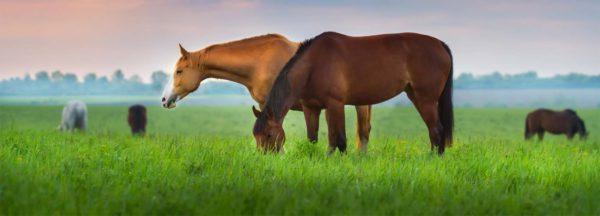Rotational Grazing is Not Just for Cattle Anymore

By Ritchie Industries
Most horse farms practice continuous grazing, but more and more horse owners are discovering the benefits of rotational grazing. Even if you just have one acre, splitting your pasture into two grazing paddocks and rotating between them produces healthier and thicker pastures that provide better nutrition for your horses.
Rotational vs. Continuous Grazing
Rotational grazing involves the use of several pastures or paddocks, one of which is grazed while the others are rested before being re-grazed. Continuous grazing is the use of one pasture for the entire grazing season. Traditional continuous grazing systems may use only 30 to 50% of the available forage. Compare this to pastures that are rotationally grazed. Shortening the grazing periods to three to seven days increases utilization 50 to 65%; to two days, 55 to 70%; and to one day, 60 to 75%. Keep in mind that horses are spot grazers and may graze certain areas down to dirt and leave other areas overgrown. Mowing may be needed to maintain the paddocks at the proper height and reduce a horse’s propensity to spot graze.
“Horses have a tendency to graze their favorite grass species close to the ground, then return to graze the regrowth as soon as it appears,” said Laura Kenny, Equine Extension Educator for Penn State Extension. “This is called overgrazing, and it is very damaging to grass plants. First, it removes so much of the leaf area that the plant can’t capture sunlight to make energy for regrowth. The plant must then use stored energy to regrow, and with repeated close grazing, the energy stores run out and the plant dies.”
Once beneficial forages such as orchard grass, smooth brome, and timothy die, then weeds or other less desirable grasses take the opportunity to grow and reduce the productivity of your pasture.
Plan Your Grazing Paddocks
The ideal grazing system would be designed as a central hub with a shelter, a sacrifice (heavy use) lot, automatic waterer and four connected paddocks. According to Krista Lea, coordinator of the University of Kentucky’s Horse Pasture Evaluation Program, horse owners who may not have an ideal setup can utilize what is referred to as “paired pastures.”
This simple approach pairs two pastures that are similar in size and quality of forage. The horses will be rotating between the two paddocks approximately every two weeks.
Another option is to simply split a pasture into two parcels and rotate between them. Temporary or portable fencing can be used to set up your paddocks quickly and easily. Solar powered energizers are easy to move and a great way to power electric fencing.
Rest is the Key to Success in Rotational Grazing
The growth rate of grasses and forages will vary depending on the plant species, soil health and weather conditions. The biggest factor to determine the success of your rotational grazing is rest.
If you are rotating between two paddocks, make sure to give the pasture two weeks of rest between grazing. As you add more paddocks, you will shorten the time between grazings and you will notice that the horses will graze more of each paddock at one time.
According to Kenny at Penn State Extension, the general recommendation is to follow the “take half, leave half rule.” Horses graze a paddock until they consume around 50% of the forage. Horses should graze a paddock when the average forage height is six to eight inches and then moved to another paddock when the forage height is three to four inches. Make sure that your pastures are not grazed below three inches to maintain plant health.
Be willing to try and experiment with paddock layouts until you can achieve a good rotational balance.
Water Placement is Also Important
Delivering clean, fresh water to each grazing paddock is also important to help maximize pasture use and maintain horse health. Ideally, a centrally located area with an automatic waterer that is connected to all paddocks is preferred. If one central automatic waterer doesn’t fit your farm’s layout, then consider installing an automatic waterer in a split fence configuration. There are also portable automatic waterers that use a standard garden hose hook-up that can be easily moved from paddock to paddock.
The Bottom Line
Rotational grazing requires more planning and management than continuous grazing, but the benefits are good for both horses and the land. Proper rotational grazing management will strike the right balance between providing good forage utilization with forage availability.
To learn more about planning, selecting and installing automatic waterers, visit RitchieFount.com today.
To learn more about rotational grazing visit:
Penn State Extension | Penn State Extension (psu.edu)
University of Kentucky | Forage Extension Home (uky.edu)
